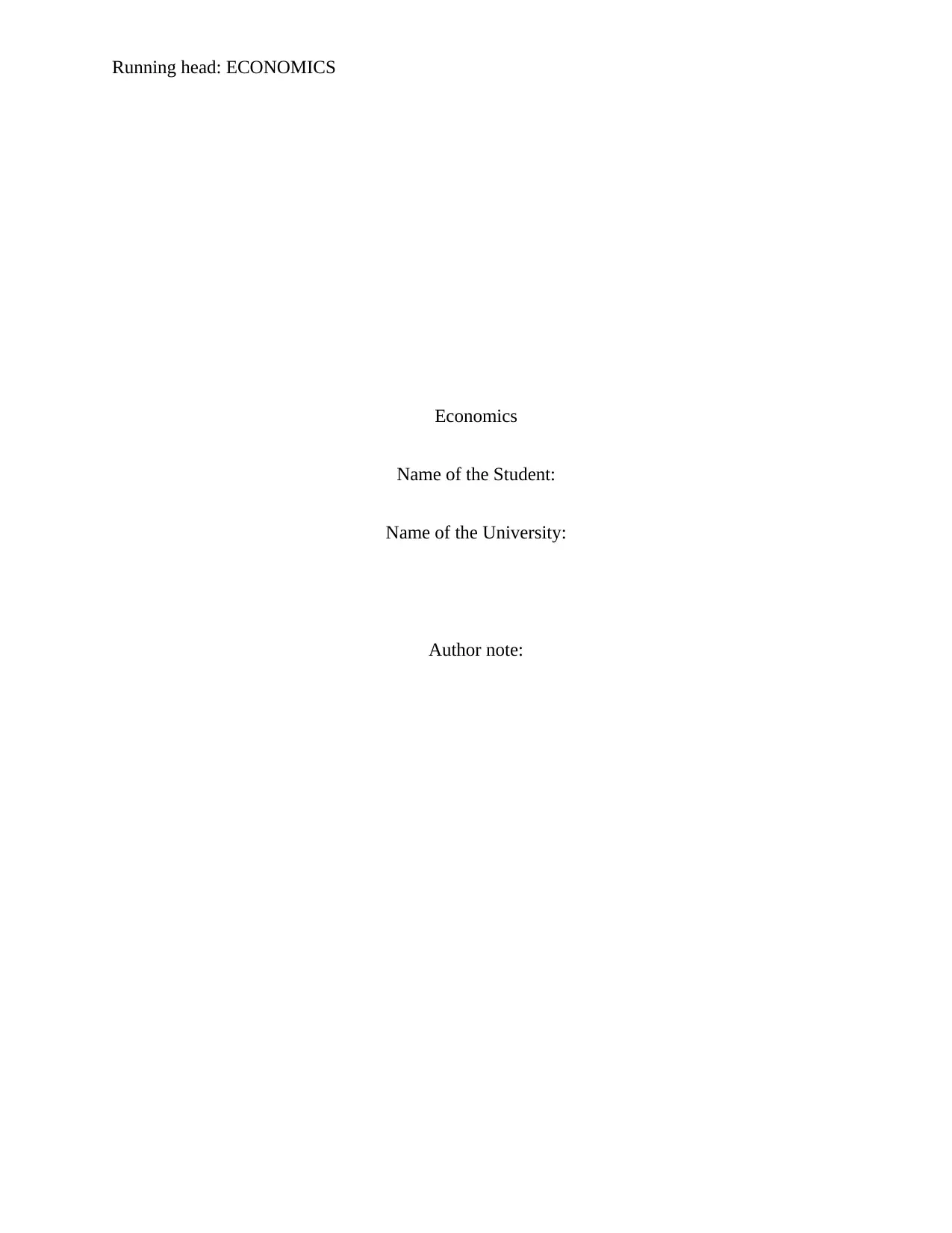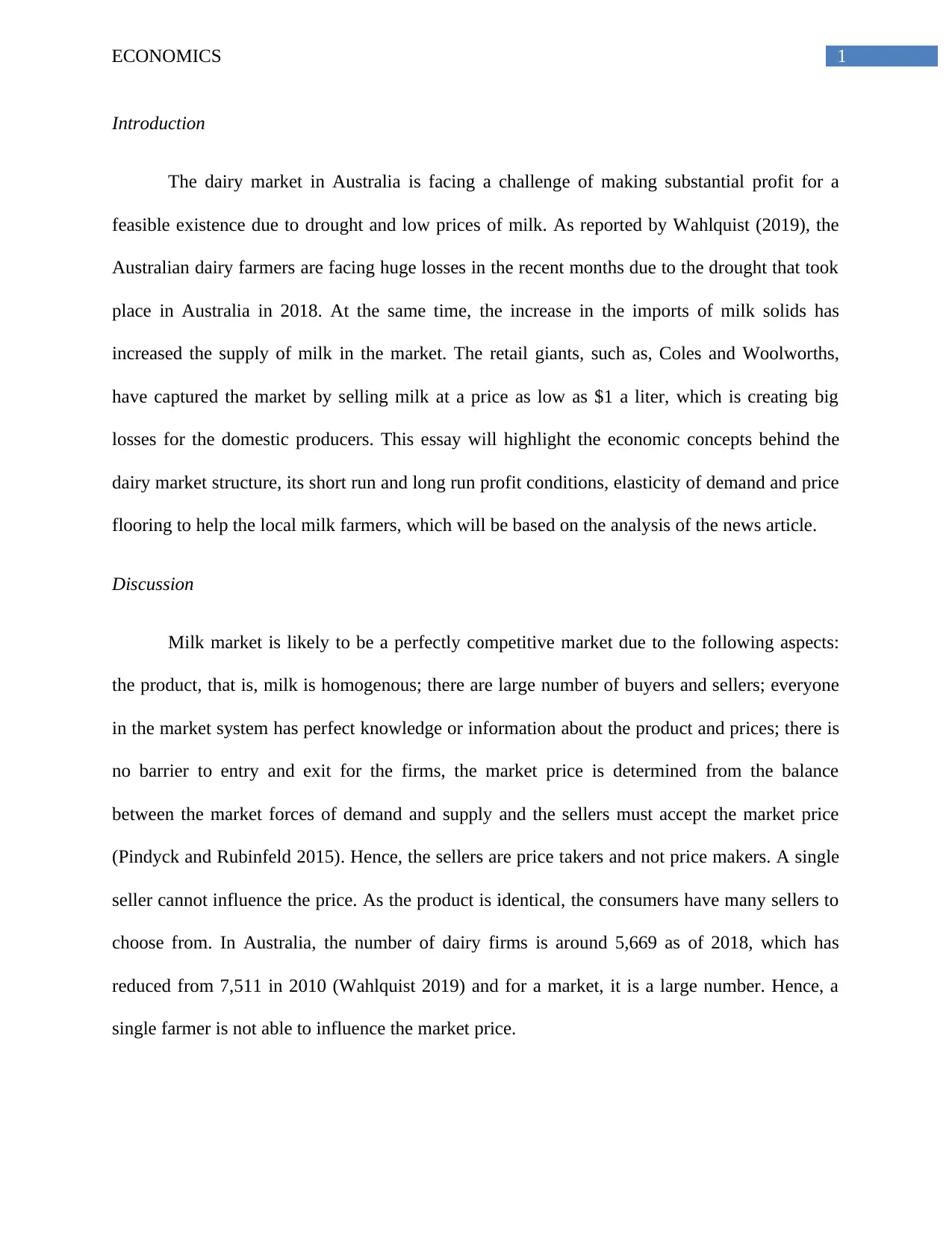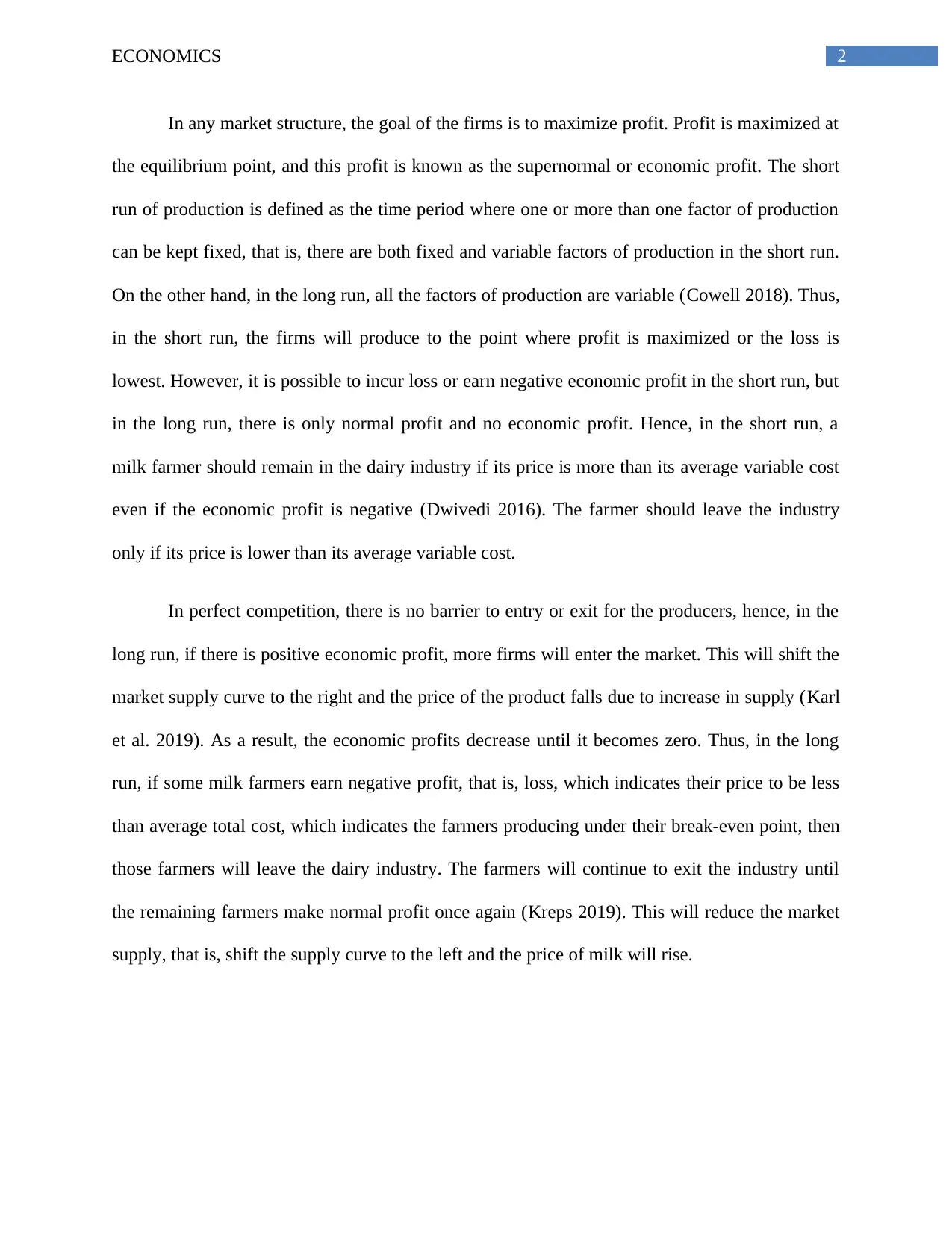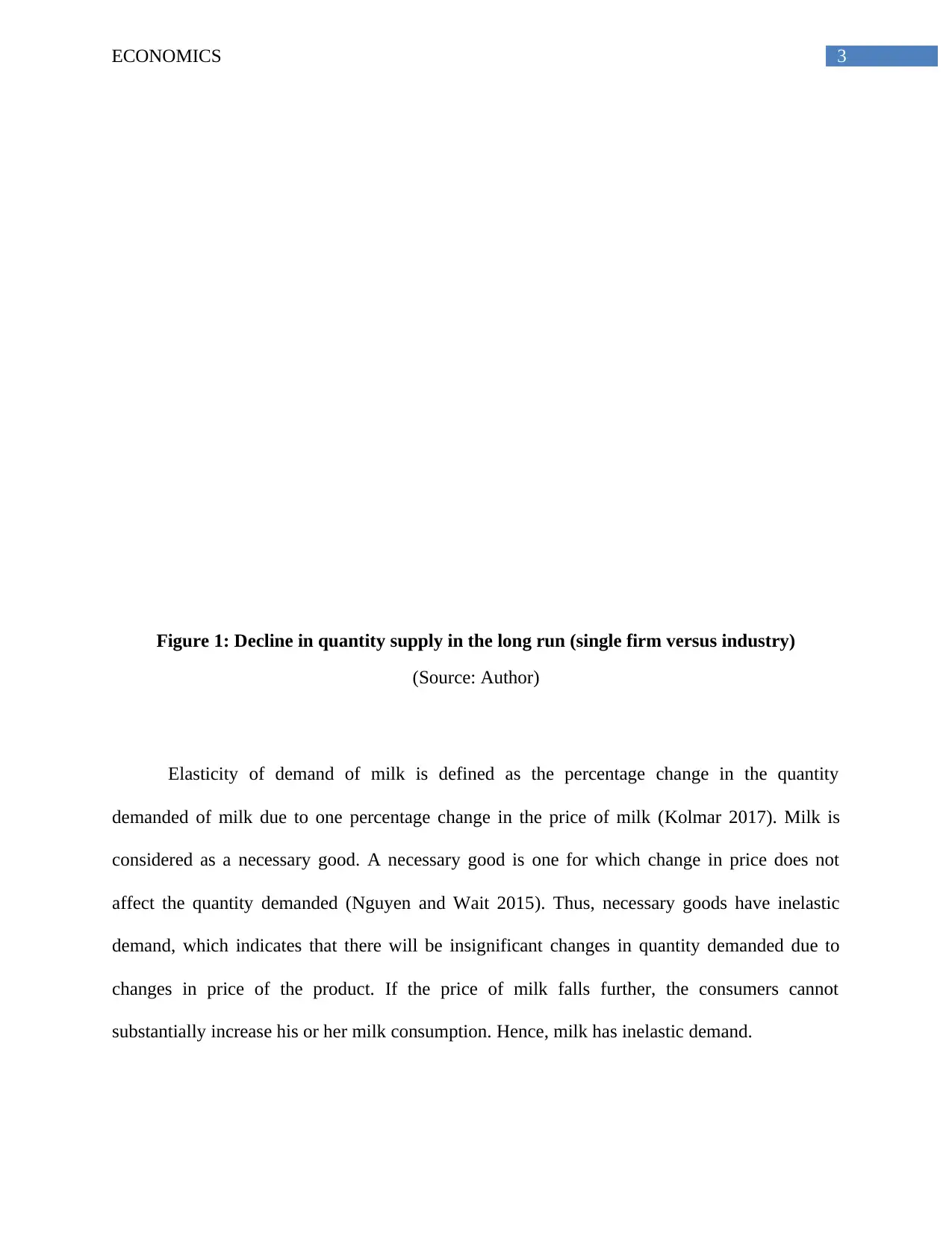Analysis of the Australian Dairy Market: An Economics Essay
VerifiedAdded on 2022/11/16
|7
|1596
|230
Essay
AI Summary
This essay provides an economic analysis of the Australian dairy market, focusing on the challenges faced by farmers due to drought and low milk prices. It begins by classifying the market as perfectly competitive, explaining why individual farmers are price takers. The essay then explores short-run and long-run profit conditions, including the decision of farmers to remain in the industry despite losses in the short term. The analysis includes graphical representations of market dynamics. The essay also examines the inelastic demand for milk and discusses the potential of government interventions, such as price floors, to support local producers. The conclusion summarizes the key findings, emphasizing the market's competitive nature, the importance of price floors, and the inelastic demand for milk, offering insights into the economic factors influencing the Australian dairy industry.

Running head: ECONOMICS
Economics
Name of the Student:
Name of the University:
Author note:
Economics
Name of the Student:
Name of the University:
Author note:
Paraphrase This Document
Need a fresh take? Get an instant paraphrase of this document with our AI Paraphraser

1ECONOMICS
Introduction
The dairy market in Australia is facing a challenge of making substantial profit for a
feasible existence due to drought and low prices of milk. As reported by Wahlquist (2019), the
Australian dairy farmers are facing huge losses in the recent months due to the drought that took
place in Australia in 2018. At the same time, the increase in the imports of milk solids has
increased the supply of milk in the market. The retail giants, such as, Coles and Woolworths,
have captured the market by selling milk at a price as low as $1 a liter, which is creating big
losses for the domestic producers. This essay will highlight the economic concepts behind the
dairy market structure, its short run and long run profit conditions, elasticity of demand and price
flooring to help the local milk farmers, which will be based on the analysis of the news article.
Discussion
Milk market is likely to be a perfectly competitive market due to the following aspects:
the product, that is, milk is homogenous; there are large number of buyers and sellers; everyone
in the market system has perfect knowledge or information about the product and prices; there is
no barrier to entry and exit for the firms, the market price is determined from the balance
between the market forces of demand and supply and the sellers must accept the market price
(Pindyck and Rubinfeld 2015). Hence, the sellers are price takers and not price makers. A single
seller cannot influence the price. As the product is identical, the consumers have many sellers to
choose from. In Australia, the number of dairy firms is around 5,669 as of 2018, which has
reduced from 7,511 in 2010 (Wahlquist 2019) and for a market, it is a large number. Hence, a
single farmer is not able to influence the market price.
Introduction
The dairy market in Australia is facing a challenge of making substantial profit for a
feasible existence due to drought and low prices of milk. As reported by Wahlquist (2019), the
Australian dairy farmers are facing huge losses in the recent months due to the drought that took
place in Australia in 2018. At the same time, the increase in the imports of milk solids has
increased the supply of milk in the market. The retail giants, such as, Coles and Woolworths,
have captured the market by selling milk at a price as low as $1 a liter, which is creating big
losses for the domestic producers. This essay will highlight the economic concepts behind the
dairy market structure, its short run and long run profit conditions, elasticity of demand and price
flooring to help the local milk farmers, which will be based on the analysis of the news article.
Discussion
Milk market is likely to be a perfectly competitive market due to the following aspects:
the product, that is, milk is homogenous; there are large number of buyers and sellers; everyone
in the market system has perfect knowledge or information about the product and prices; there is
no barrier to entry and exit for the firms, the market price is determined from the balance
between the market forces of demand and supply and the sellers must accept the market price
(Pindyck and Rubinfeld 2015). Hence, the sellers are price takers and not price makers. A single
seller cannot influence the price. As the product is identical, the consumers have many sellers to
choose from. In Australia, the number of dairy firms is around 5,669 as of 2018, which has
reduced from 7,511 in 2010 (Wahlquist 2019) and for a market, it is a large number. Hence, a
single farmer is not able to influence the market price.

2ECONOMICS
In any market structure, the goal of the firms is to maximize profit. Profit is maximized at
the equilibrium point, and this profit is known as the supernormal or economic profit. The short
run of production is defined as the time period where one or more than one factor of production
can be kept fixed, that is, there are both fixed and variable factors of production in the short run.
On the other hand, in the long run, all the factors of production are variable (Cowell 2018). Thus,
in the short run, the firms will produce to the point where profit is maximized or the loss is
lowest. However, it is possible to incur loss or earn negative economic profit in the short run, but
in the long run, there is only normal profit and no economic profit. Hence, in the short run, a
milk farmer should remain in the dairy industry if its price is more than its average variable cost
even if the economic profit is negative (Dwivedi 2016). The farmer should leave the industry
only if its price is lower than its average variable cost.
In perfect competition, there is no barrier to entry or exit for the producers, hence, in the
long run, if there is positive economic profit, more firms will enter the market. This will shift the
market supply curve to the right and the price of the product falls due to increase in supply (Karl
et al. 2019). As a result, the economic profits decrease until it becomes zero. Thus, in the long
run, if some milk farmers earn negative profit, that is, loss, which indicates their price to be less
than average total cost, which indicates the farmers producing under their break-even point, then
those farmers will leave the dairy industry. The farmers will continue to exit the industry until
the remaining farmers make normal profit once again (Kreps 2019). This will reduce the market
supply, that is, shift the supply curve to the left and the price of milk will rise.
In any market structure, the goal of the firms is to maximize profit. Profit is maximized at
the equilibrium point, and this profit is known as the supernormal or economic profit. The short
run of production is defined as the time period where one or more than one factor of production
can be kept fixed, that is, there are both fixed and variable factors of production in the short run.
On the other hand, in the long run, all the factors of production are variable (Cowell 2018). Thus,
in the short run, the firms will produce to the point where profit is maximized or the loss is
lowest. However, it is possible to incur loss or earn negative economic profit in the short run, but
in the long run, there is only normal profit and no economic profit. Hence, in the short run, a
milk farmer should remain in the dairy industry if its price is more than its average variable cost
even if the economic profit is negative (Dwivedi 2016). The farmer should leave the industry
only if its price is lower than its average variable cost.
In perfect competition, there is no barrier to entry or exit for the producers, hence, in the
long run, if there is positive economic profit, more firms will enter the market. This will shift the
market supply curve to the right and the price of the product falls due to increase in supply (Karl
et al. 2019). As a result, the economic profits decrease until it becomes zero. Thus, in the long
run, if some milk farmers earn negative profit, that is, loss, which indicates their price to be less
than average total cost, which indicates the farmers producing under their break-even point, then
those farmers will leave the dairy industry. The farmers will continue to exit the industry until
the remaining farmers make normal profit once again (Kreps 2019). This will reduce the market
supply, that is, shift the supply curve to the left and the price of milk will rise.
⊘ This is a preview!⊘
Do you want full access?
Subscribe today to unlock all pages.

Trusted by 1+ million students worldwide

3ECONOMICS
Price/ Costs Price
S1
S2
P1
P2 D=AR=MR
LAC
MC
Q1 Q1Q2Q2
D
QQ
Single firm Dairy Industry
Figure 1: Decline in quantity supply in the long run (single firm versus industry)
(Source: Author)
Elasticity of demand of milk is defined as the percentage change in the quantity
demanded of milk due to one percentage change in the price of milk (Kolmar 2017). Milk is
considered as a necessary good. A necessary good is one for which change in price does not
affect the quantity demanded (Nguyen and Wait 2015). Thus, necessary goods have inelastic
demand, which indicates that there will be insignificant changes in quantity demanded due to
changes in price of the product. If the price of milk falls further, the consumers cannot
substantially increase his or her milk consumption. Hence, milk has inelastic demand.
Price/ Costs Price
S1
S2
P1
P2 D=AR=MR
LAC
MC
Q1 Q1Q2Q2
D
Single firm Dairy Industry
Figure 1: Decline in quantity supply in the long run (single firm versus industry)
(Source: Author)
Elasticity of demand of milk is defined as the percentage change in the quantity
demanded of milk due to one percentage change in the price of milk (Kolmar 2017). Milk is
considered as a necessary good. A necessary good is one for which change in price does not
affect the quantity demanded (Nguyen and Wait 2015). Thus, necessary goods have inelastic
demand, which indicates that there will be insignificant changes in quantity demanded due to
changes in price of the product. If the price of milk falls further, the consumers cannot
substantially increase his or her milk consumption. Hence, milk has inelastic demand.
Paraphrase This Document
Need a fresh take? Get an instant paraphrase of this document with our AI Paraphraser

4ECONOMICS
According to the report, the Australian milk farmers are suffering losses due to drought
and low milk price. On one hand, drought has resulted in the decline in local supply of milk, on
the other hand, the supermarket giants have taken the advantage of excess supply of milk solids
and have reduced the price of their home brand milks. To help the milk farmers, the Australian
government can impose price control measures, such as, price floor policy. As highlighted by
Fine (2016), price floor refers to the lowest legal price of a product or service that the producer
can charge from the consumers. Thus, price floor is imposed to prevent the prices from falling
too low, although it creates surplus in the market. It is mostly used in the agricultural industry to
protect the farmers (Curtis and Irvine 2018). Thus, in case of dairy industry also, the Australian
government can use the price flooring to set a minimum price for the milk, which can protect the
interest of the local producers.
Conclusion
From the above discussion, it can be concluded that the milk industry of Australia is a
perfectly competitive market, which follows each characteristics of the perfect competition. As
the milk farmers are price takers, a single farmer cannot influence the market price for milk. The
farmers can earn negative profit in the short run, but if the price is more than their average
variable cost of production, then the farmers should not leave the industry in the short run. It is
highly possible that in the long run, when all the factors of production are variable, the price
equals average cost of production. This indicates that in the long run, there is only normal profit
and no supernormal profit. This discourages new farmers from entering the market and the
farmers who are making losses in the long run, would leave the industry. This decreases the total
market supply and as a result, price of milk increases until all the remaining farmers are earning
normal profit. Milk is a necessary good, and hence, it has inelastic demand. In other words, even
According to the report, the Australian milk farmers are suffering losses due to drought
and low milk price. On one hand, drought has resulted in the decline in local supply of milk, on
the other hand, the supermarket giants have taken the advantage of excess supply of milk solids
and have reduced the price of their home brand milks. To help the milk farmers, the Australian
government can impose price control measures, such as, price floor policy. As highlighted by
Fine (2016), price floor refers to the lowest legal price of a product or service that the producer
can charge from the consumers. Thus, price floor is imposed to prevent the prices from falling
too low, although it creates surplus in the market. It is mostly used in the agricultural industry to
protect the farmers (Curtis and Irvine 2018). Thus, in case of dairy industry also, the Australian
government can use the price flooring to set a minimum price for the milk, which can protect the
interest of the local producers.
Conclusion
From the above discussion, it can be concluded that the milk industry of Australia is a
perfectly competitive market, which follows each characteristics of the perfect competition. As
the milk farmers are price takers, a single farmer cannot influence the market price for milk. The
farmers can earn negative profit in the short run, but if the price is more than their average
variable cost of production, then the farmers should not leave the industry in the short run. It is
highly possible that in the long run, when all the factors of production are variable, the price
equals average cost of production. This indicates that in the long run, there is only normal profit
and no supernormal profit. This discourages new farmers from entering the market and the
farmers who are making losses in the long run, would leave the industry. This decreases the total
market supply and as a result, price of milk increases until all the remaining farmers are earning
normal profit. Milk is a necessary good, and hence, it has inelastic demand. In other words, even

5ECONOMICS
if its price falls, the consumers cannot increase their consumption substantially. Lastly, it is seen
that to protect the interest of the local individual farmers, the government can impose price
flooring and set the minimum price for milk.
if its price falls, the consumers cannot increase their consumption substantially. Lastly, it is seen
that to protect the interest of the local individual farmers, the government can impose price
flooring and set the minimum price for milk.
⊘ This is a preview!⊘
Do you want full access?
Subscribe today to unlock all pages.

Trusted by 1+ million students worldwide

6ECONOMICS
References
Cowell, F., 2018. Microeconomics: principles and analysis. Oxford University Press.
Curtis, D. and Irvine, I., 2018. Microeconomics: Markets, Methods & Models (Lyryx).
Dwivedi, D.N., 2016. Microeconomics: Theory and Applications. Vikas Publishing House.
Fine, B., 2016. Microeconomics. University of Chicago Press Economics Books.
Karl, E., CASE, F., OSTER, R. and SHARON, E., 2019. PRINCIPLES OF
MICROECONOMICS. Pearson.
Kolmar, M., 2017. Supply and Demand Under Perfect Competition. In Principles of
Microeconomics (pp. 55-82). Springer, Cham.
Kreps, D.M., 2019. Microeconomics for managers. Princeton University Press.
Malek, N.P., 2019. One-Shot Game: A Free-Market Approach to the Principles of
Microeconomics Class. In Teaching Economics (pp. 33-43). Springer, Cham.
Nguyen, B. and Wait, A., 2015. Essentials of Microeconomics. Routledge.
Pindyck, R.S. and Rubinfeld, D.L., 2015. Microeconomics.
Wahlquist, C., 2019. Drought and low milk prices push dairy farmers to the brink. The
Guardian. [online] Available at: https://www.theguardian.com/food/2019/feb/24/drought-and-
low-milk-prices-push-dairy-farmers-to-the-brink [accessed 14 Sept 2019].
References
Cowell, F., 2018. Microeconomics: principles and analysis. Oxford University Press.
Curtis, D. and Irvine, I., 2018. Microeconomics: Markets, Methods & Models (Lyryx).
Dwivedi, D.N., 2016. Microeconomics: Theory and Applications. Vikas Publishing House.
Fine, B., 2016. Microeconomics. University of Chicago Press Economics Books.
Karl, E., CASE, F., OSTER, R. and SHARON, E., 2019. PRINCIPLES OF
MICROECONOMICS. Pearson.
Kolmar, M., 2017. Supply and Demand Under Perfect Competition. In Principles of
Microeconomics (pp. 55-82). Springer, Cham.
Kreps, D.M., 2019. Microeconomics for managers. Princeton University Press.
Malek, N.P., 2019. One-Shot Game: A Free-Market Approach to the Principles of
Microeconomics Class. In Teaching Economics (pp. 33-43). Springer, Cham.
Nguyen, B. and Wait, A., 2015. Essentials of Microeconomics. Routledge.
Pindyck, R.S. and Rubinfeld, D.L., 2015. Microeconomics.
Wahlquist, C., 2019. Drought and low milk prices push dairy farmers to the brink. The
Guardian. [online] Available at: https://www.theguardian.com/food/2019/feb/24/drought-and-
low-milk-prices-push-dairy-farmers-to-the-brink [accessed 14 Sept 2019].
1 out of 7
Related Documents
Your All-in-One AI-Powered Toolkit for Academic Success.
+13062052269
info@desklib.com
Available 24*7 on WhatsApp / Email
![[object Object]](/_next/static/media/star-bottom.7253800d.svg)
Unlock your academic potential
Copyright © 2020–2025 A2Z Services. All Rights Reserved. Developed and managed by ZUCOL.





